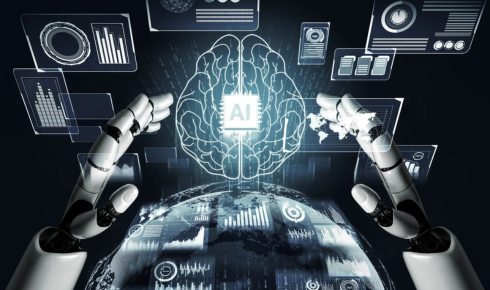Artificial Intelligence (AI) is no longer just a buzzword — it’s rapidly becoming the backbone of innovation across industries. From powering smart assistants to driving autonomous vehicles and predicting market trends, AI systems are transforming how businesses operate and how people live. At the heart of this revolution lies AI development — the process of designing, building, training, and deploying intelligent systems that can simulate human behavior, learn from data, and make autonomous decisions.
This article explores what AI systems are, how AI development works, and why businesses and governments alike are investing heavily in the future of intelligent technology.
What Is an AI System?
An AI system refers to a software or hardware solution that can perform tasks typically requiring human intelligence. These tasks may include:
- Learning from data (machine learning)
- Recognizing images or speech
- Understanding natural language
- Making decisions and predictions
- Automating complex workflows
AI systems can range from simple rule-based programs to advanced deep learning models that mimic the neural activity of the human brain.
Some everyday examples of AI systems include:
- Virtual assistants like Siri, Alexa, or Google Assistant
- Recommendation engines used by Netflix, YouTube, or Amazon
- Chatbots in customer support
- Fraud detection systems in banking
- Predictive maintenance systems in manufacturing
As businesses grow more data-driven, the demand for robust, scalable AI systems continues to rise — and this is where AI development becomes a critical competency.
The Core Components of AI Systems
To understand the complexity of building intelligent systems, let’s break down the typical components of an AI system:
- Data Collection & Management
Every AI system relies on data — structured or unstructured — to learn and improve. High-quality, well-labeled data is critical for training accurate models. - Algorithms & Models
AI development involves choosing the right algorithms (e.g., neural networks, decision trees, reinforcement learning) to solve specific problems. - Training & Testing
Models are trained using historical data and tested for accuracy, bias, and performance before deployment. - Infrastructure
AI systems require computing power, often involving GPUs, cloud platforms, and specialized hardware to handle complex computations. - Deployment & Monitoring
Once trained, the AI model is integrated into production environments. Continuous monitoring ensures it remains accurate, fair, and secure.
AI Development: The Process of Building Intelligent Systems
AI development is a multidisciplinary field involving data science, machine learning, software engineering, and domain expertise. The development cycle includes several key stages:
1. Problem Definition
Before creating an AI system, developers must clearly define the problem to solve. Is it image recognition? Language translation? Predicting churn? Precise goals drive accurate development.
2. Data Engineering
Data must be collected, cleaned, labeled, and transformed. AI models are only as good as the data they learn from, making data engineering one of the most critical steps in AI development.
3. Model Selection & Training
Machine learning engineers select appropriate models — from linear regression to advanced deep neural networks — and train them on the dataset using frameworks like TensorFlow or PyTorch.
4. Evaluation & Optimization
After training, the model is tested using unseen data. Developers evaluate performance metrics (accuracy, precision, recall, F1-score) and fine-tune the model to improve results.
5. Integration & Deployment
The AI model is then integrated into a business application or product. This may involve API development, cloud deployment, containerization (e.g., Docker), or edge deployment for IoT devices.
6. Monitoring & Maintenance
AI development doesn’t end at deployment. AI systems must be monitored continuously for model drift, performance issues, and bias, with updates applied regularly.
Real-World Applications of AI Systems
Modern AI development is unlocking value in almost every sector. Here are just a few industries where AI systems are making a major impact:
Healthcare
- AI-powered diagnostic tools can detect diseases from X-rays, MRIs, and other scans.
- Predictive models help hospitals manage patient loads and resources.
- AI chatbots provide 24/7 health support and symptom checking.
Finance
- AI systems detect fraudulent transactions in real-time.
- Algorithmic trading uses AI models to predict market movements.
- Credit scoring and loan approvals are increasingly automated via AI.
Retail & E-Commerce
- Recommendation engines drive personalized shopping experiences.
- Chatbots and virtual assistants streamline customer service.
- Inventory management systems optimize stock based on demand forecasts.
Manufacturing
- Predictive maintenance minimizes equipment downtime.
- AI-driven robots increase efficiency and precision in production lines.
- Computer vision enables quality control and defect detection.
Transportation & Logistics
- Self-driving technology relies on AI for real-time decision-making.
- Route optimization systems reduce fuel use and improve delivery times.
- AI systems manage supply chain logistics with predictive analytics.
Why AI Development Is the Future
As technology advances, AI development is becoming more accessible, scalable, and powerful. Here are a few reasons why investing in AI development today is critical for long-term success:
- Competitive Advantage
Businesses using AI systems can automate processes, reduce costs, and deliver better customer experiences. - Data Utilization
Modern enterprises generate vast amounts of data. AI systems can extract actionable insights and drive data-based decisions. - Scalability
AI-powered tools can handle increasing workloads without requiring linear increases in human labor. - Personalization
AI systems can tailor experiences to individual users, improving engagement and satisfaction. - Innovation
From new product development to market forecasting, AI development enables groundbreaking innovation.
Challenges in AI System Development
While the potential is enormous, AI development also comes with significant challenges:
- Data Privacy & Ethics
AI systems must comply with regulations like GDPR and avoid unethical use of data. - Bias & Fairness
Poorly trained AI can inherit and amplify biases present in the training data. - Talent Shortage
Skilled AI developers and data scientists are in high demand and short supply. - Complexity & Cost
Developing a reliable, production-ready AI system is time-intensive and resource-heavy.
Despite these hurdles, advances in tools, cloud services, and open-source frameworks are helping more businesses adopt and benefit from AI.
The Role of AI Development Services
To navigate these complexities, many organizations turn to specialized AI development services. These services provide:
- AI strategy consulting
- End-to-end development (data → deployment)
- Custom AI system design
- Model training, validation, and tuning
- Infrastructure and deployment support
- Maintenance, updates, and model retraining
By partnering with an experienced AI development service provider, companies can accelerate innovation while minimizing risk.
Conclusion
The future of technology is intelligent, adaptive, and data-driven. By leveraging powerful AI systems and investing in expert AI development, organizations can transform the way they operate, compete, and grow.
Whether you’re a startup building a smart app, a hospital deploying AI diagnostics, or an enterprise optimizing supply chains — the journey begins with the right AI vision and a team to bring it to life.








